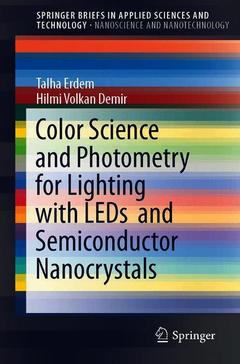Color Science and Photometry for Lighting with LEDs and Semiconductor Nanocrystals, 1st ed. 2019 Nanoscience and Nanotechnology Series
Auteurs : Erdem Talha, Demir Hilmi Volkan

This book reviews the application of semiconductor nanocrystals also known as colloidal quantum dots (QDs) to LED lighting for indoors and outdoors as well as LED backlighting in displays, summarizing the color science of QDs for lighting and displays and presenting recent developments in QD-integrated LEDs and display research. By employing QDs in color-conversion LEDs, it is possible to simultaneously accomplish successful color rendition of the illuminated objects and a good spectral overlap between the emission spectrum of the light source and the sensitivity of the human eye at a warm white color temperature ? something that is fundamentally challenging to achieve with conventional sources, such as incandescent and fluorescent lamps, and phosphor-based LEDs.
Dr. Talha Erdem completed his PhD at Bilkent University and is currently a postdoctoral fellow under the prestigious Newton International Fellowship at the Cavendish National Laboratory of the University of Cambridge, UK. His research focuses on DNA-driven self-assembly of colloidal nanocrystals and controlling the optical features of the self-assembled superlattices in real-time, and their applications to lighting displays.
Dr. Hilmi Volkan Demir is a Professor of Electrical Engineering, Physics and Materials Science. He is a Singapore NRF Fellow at NTU Singapore and is the Founding Director of LUMINOUS! Center of Excellence for Semiconductor Lighting and Displays. Concurrently, he holds a chair professorship in materials science and nanotechnology at Bilkent University UNAM – National Nanotechnology Research Center of Turkey. His current research interests include the science and technology of nanocrystal optoelectronics for semiconductor lighting; excitonics and plasmonics for high-efficiency light generation and harvesting; and wireless in vivo sensing and smart implants for future healthcare.
Date de parution : 01-2019
Ouvrage de 79 p.
15.5x23.5 cm



